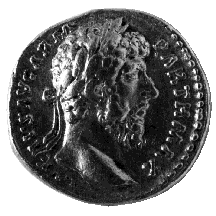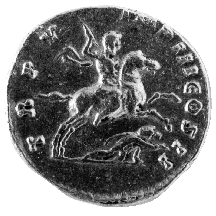



(106) Lucius Verus - AV aureus, A.D. 165, 7.45 g. (inv. 91.184).
Obverse: Laureate head of Lucius Verus r.; L(VCIVS) VERVS AVG(VSTVS) ARM(ENIACVS)
PARTH(ICVS) MAX(IMVS): Lucius Verus Augustus, restorer of Armenia, great
conqueror of the Parthians.
Reverse: Emperor on horseback r., thrusting spear at fallen enemy; TR(IBVNICIA)
P(OTESTATE) V IMP(ERATOR) III CO(N)S(VL) II: with tribunician power for
the fifth time, imperator for the third time, consul for the
second time.
Provenance: Coin Galleries, 1959.
Bibliography: H. Mattingly and E.A. Sydenham, The Roman Imperial Coinage
III: Antoninus Pius to Commodus (London 1930) 545.
Lucius Verus was co-regent with Marcus Aurelius from A.D. 161 until 169.
He was in charge of military campaigns in the East during the years A.D.
163-166. This coin celebrates the Armenian and Parthian victories during
that period. For this military activity he, along with Marcus Aurelius,
bears the titles Armeniacus and Parthicus (see no. 104).
The obverse portrait is related to a sculpted portrait type of Verus. The
type resembles that of his adoptive father, Antoninus, and brother, Marcus
Aurelius, in its curly hair and beard, but Verus has a hooked nose, a considerably
lower brow, and he lacks the upward gaze and inspired look of Aurelius.
The reverse illustration of the emperor on horseback over a fallen enemy
(here either Parthian or Armenian) is a common type. This is the numismatic
equivalent of the imperatorial equestrian statue, of which the only extant
example is the famous equestrian statue of Marcus Aurelius (see no. 102).
Today the statue lacks the trampled barbarian (the equivalent of the fallen
warrior on this coin) that would originally have been under the horse's
right front leg.
M.D.P.



All contents copyright (c) 1996.
Lawrence University
All rights reserved.